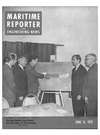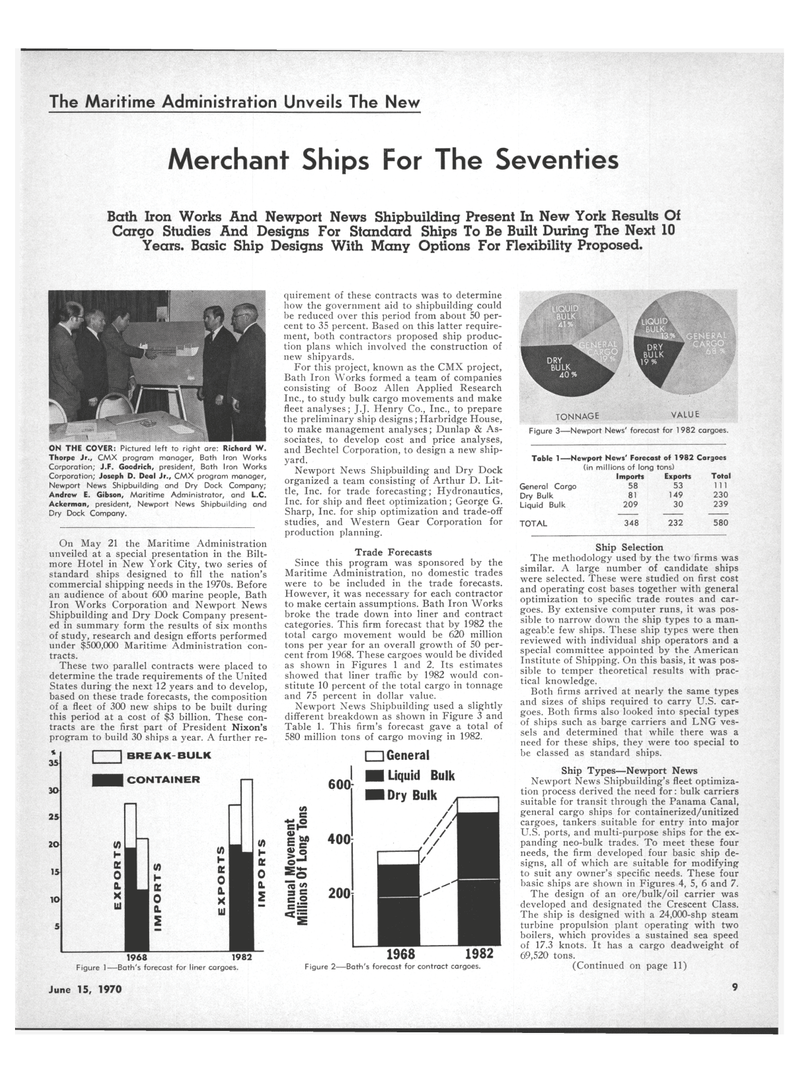
Page 7: of Maritime Reporter Magazine (June 15, 1970)
Read this page in Pdf, Flash or Html5 edition of June 15, 1970 Maritime Reporter Magazine
The Maritime Administration Unveils The New
Merchant Ships For The Seventies
Bath Iron Works And Newport News Shipbuilding Present In New York Results Of
Cargo Studies And Designs For Standard Ships To Be Built During The Next 10
Years. Basic Ship Designs With Many Options For Flexibility Proposed. mp- ilft m < ! 1 •pr \ * i jjl •SpHHiM •1 ~ 70ft r 11
I ' V
Mi i 1
ON THE COVER: Pictured left to right are: Richard W.
Thorpe Jr., CMX program manager, Bath Iron Works
Corporation; J.F. Goodrich, president, Bath Iron Works
Corporation; Joseph D. Deal Jr., CMX program manager,
Newport News Shipbuilding and Dry Dock Company;
Andrew E. Gibson, Maritime Administrator, and L.C.
Ackerman, president, Newport News Shipbuilding and
Dry Dock Company.
On May 21 the Maritime Administration unveiled at a special presentation in the Bilt- more Hotel in New York City, two series of standard ships designed to fill the nation's commercial shipping needs in the 1970s. Before an audience of about 600 marine people, Bath
Iron Works Corporation and Newport News
Shipbuilding and Dry Dock Company present- ed in summary form the results of six months of study, research and design efforts performed under $500,000 Maritime Administration con- tracts.
These two parallel contracts were placed to determine the trade requirements of the United
States during the next 12 years and to develop, based on these trade forecasts, the composition of a fleet of 300 new ships to be built during this period at a cost of $3 billion. These con- tracts are the first part of President Nixon's program to build 30 ships a year. A further re- 351
JO 25 20 15 lO 5 | | BREAK-BULK
CONTAINER quirement of these contracts was to determine how the government aid to shipbuilding could be reduced over this period from about 50 per- cent to 35 percent. Based on this latter require- ment, both contractors proposed ship produc- tion plans which involved the construction of new shipyards.
For this project, known as the CMX project,
Bath Iron Works formed a team of companies consisting of Booz Allen Applied Research
Inc., to study bulk cargo movements and make fleet analyses; J.J. Henry Co., Inc., to prepare the preliminary ship designs; Harbridge House, to make management analyses; Dunlap & As- sociates, to develop cost and price analyses, and Bechtel Corporation, to design a new ship- yard.
Newport News Shipbuilding and Dry Dock organized a team consisting of Arthur D. Lit- tle, Inc. for trade forecasting; Hydronautics,
Inc. for ship and fleet optimization; George G.
Sharp, Inc. for ship optimization and trade-off studies, and Western Gear Corporation for production planning.
Trade Forecasts
Since this program was sponsored by the
Maritime Administration, no domestic trades were to be included in the trade forecasts.
However, it was necessary for each contractor to make certain assumptions. Bath Iron Works broke the trade down into liner and contract categories. This firm forecast that by 1982 the total cargo movement would be 620 million tons per year for an overall growth of 50 per- cent from 1968. These cargoes would be divided as shown in Figures 1 and 2. Its estimates showed that liner traffic by 1982 would con- stitute 10 percent of the total cargo in tonnage and 75 percent in dollar value.
Newport News Shipbuilding used a slightly different breakdown as shown in Figure 3 and
Table 1. This firm's forecast gave a total of
580 million tons of cargo moving in 1982.
S
•*-• o CI"
S> o
CO <2 II
600
400
I I General
• Liquid Bulk
•I Dry Bulk
TONNAGE VALUE
Figure 3—Newport News' forecast for 1982 cargoes.
Table 1—Newport News' Forecast of 1982 Cargoes
(in millions of long tons)
Imports Exports Total
General Cargo 58 53 111
Dry Bulk 81 149 230
Liquid Bulk 209 30 239
TOTAL 348 232 580
1968 1982
Figure 1—Bath's forecast for liner cargoes.
1968 1982
Figure 2—Bath's forecast for contract cargoes.
Ship Selection
The methodology used by the two firms was
similar. A large number of candidate ships
were selected. These were studied on first cost
and operating cost bases together with general
optimization to specific trade routes and car-
goes. By extensive computer runs, it was pos-
sible to narrow down the ship types to a man-
ageable few ships. These ship types were then
reviewed with individual ship operators and a
special committee appointed by the American
Institute of Shipping. On this basis, it was pos-
sible to temper theoretical results with prac-
tical knowledge.
Both firms arrived at nearly the same types
and sizes of ships required to carry U.S. car-
goes. Both firms also looked into special types
of ships such as barge carriers and LNG ves-
sels and determined that while there was a
need for these ships, they were too special to
be classed as standard ships.
Ship Types—Newport News
Newport News Shipbuilding's fleet optimiza-
tion process derived the need for: bulk carriers
suitable for transit through the Panama Canal,
general cargo ships for containerized/unitized
cargoes, tankers suitable for entry into major
U.S. ports, and multi-purpose ships for the ex-
panding neo-bulk trades. To meet these four
needs, the firm developed four basic ship de-
signs, all of which are suitable for modifying
to suit any owner's specific needs. These four
basic ships are shown in Figures 4, 5, 6 and 7.
The design of an ore/bulk/oil carrier was
developed and designated the Crescent Class.
The ship is designed with a 24,000-shp steam
turbine propulsion plant operating with two
boilers, which provides a sustained sea speed
of 17.3 knots. It has a cargo deadweight of
69,520 tons.
(Continued on page 11)
June 15, 1970 9

 6
6

 8
8
